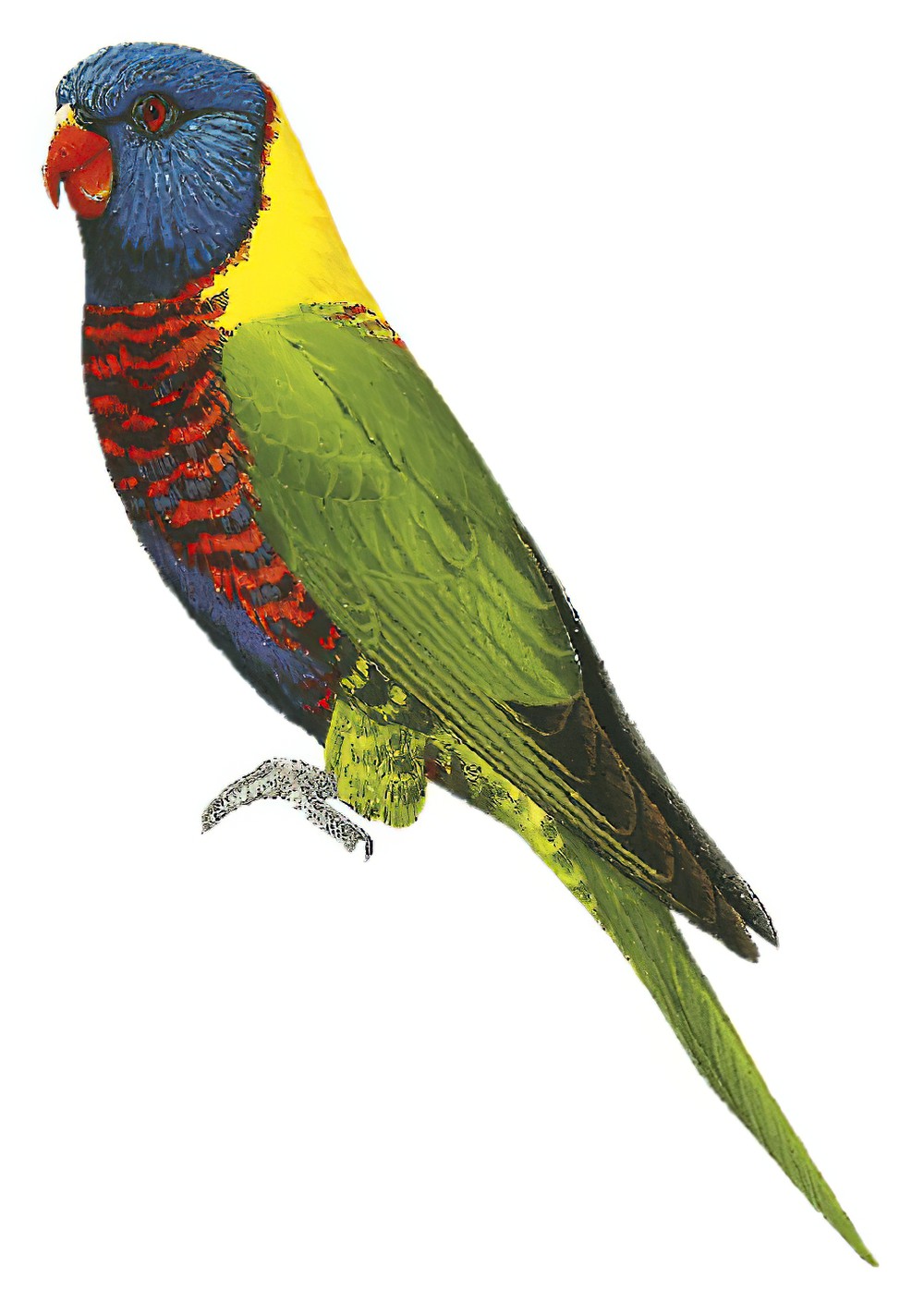Coconut Lorikeet / Trichoglossus haematodus

Coconut Lorikeet
SCI Name:
Protonym: Psittacus haematod. MantissaPlant. p.524
Taxonomy: Psittaciformes / Psittaculidae / Trichoglossus
Taxonomy Code: railor4
Type Locality: Amboina ex Brisson.
Author: Linnaeus
Publish Year: 1771
IUCN Status: Least Concern
DEFINITIONS
TRICHOGLOSSUS
(Psittacidae; Ϯ Coconut Lorikeet T. haematodus) Gr. θριξ thrix, τριχος trikhos hair; γλωσσα glōssa tongue; "GENUS CCXVII.— TRICHOGLOSSUS, Vigors. Rostrum subcrassum, mandibula superior arcuata, inferior subelongata. Lingua apice setosa. Alæ mediocres. Pedes breves; tarsi mediocres. Cauda subbrevis. THE Trichoglossi appear to belong to the old world, New Holland, and the Pacific Islands. Sp. 1. Tr. hæmatopus. Psittacus hæmatopus. Gmel. Syst. Nat. I. p. 357.— Psittacus cyanogaster. Shaw, v. viii. p. 413.— Molucca Islands. Sp. 2. Tr. capistratus. Psittacus capistratus. Beckst.— Psittacus hæmatodes. Shaw, v. viii. p. 415.—Amboyna? Sp. 3. Tr. concinnus. Psittacus concinnus. Shaw, Nat. Misc.—New Holland. Sp. 4. Tr. pusillus. Psittacus pusillus. Shaw, v. viii. p. 471.—New Holland. Sp. 5. Tr? Taitianus. Psittacus Porphyrio. Shaw, v. viii. p. 473. pl. 70.—Otaheite. Sp. 6. Tr? australis. ... Psittacus australis. Nova Act. Acad. Nat. Cur. (Kuhl.) v. x. p. 48. INHABITS New Holland. ... Sp. 7. Tr? chlorolepidotus. ... Psittacus chlorolepidotus. Nova Act. Acad. Cur. (Kuhl.) v. x. p. 48. INHABITS New Holland." (Stephens 1826); “Genus, TRICHOGLOSSUS *. ... Lingua setis plurimis marginalibus ad apicem subtus instructa. ... a decided ground of distinction is exhibited in the formation of the tongue. The under part of this member is furnished at the apex with numerous strong hairs or bristles, of a brush-like structure; and which seem to serve the bird for the purpose of suction. ... *Θριξ seta, and γλωσσα lingua” (Vigors & Horsfield 1827); "Trichoglossus Stephens, in Shaw's Gen. Zool. vol. xiv. p. 129, 1826 (late), ex Vigors & Horsfield, Zool. Journ. vol. ii. p. 281, July 1825, nude name. Type (by subsequent designation, Lesson, Man. d'Orn. vol. ii. p. 147, 1828: T. hæmatodus = T. hæmatopus Steph. = Psittacus moluccanus Gmelin." (Mathews 1927, 292); "Trichoglossus Vigors and Horsfield, Trans. Linn. Soc. London, 15, pt. 1, 1827 (1826), p. 287. Type, by subsequent designation, Psittacus haematodus Linné = Psittacus haematod Linné (G. R. Gray, List Gen. Bds., 1840, p. 51)." (Peters 1937, III, 147); "TRICHOGLOSSUS Stephens, 1826 M — Psittacus haematodus Linnaeus, 1771; type by subsequent designation (Lesson, 1828, Manuel d'Ornithologie, 2, p. 147)." (Dickinson & Remsen (eds.) 2013, 382).
Var. Tricoglossus, Trichoglossa.
Synon. Australasia, Eutelipsitta, Oenopsittacus.
haematodes / haematodus
Gr. αἱματωδης haimatōdēs blood-red < αἱμα haima, αἱματος haimatos blood.
SUBSPECIES
Coconut Lorikeet (Biak)
SCI Name: Trichoglossus haematodus rosenbergii
rosenbergi / rosenbergii
● William Frederick Henry Rosenberg (1868-1957) British natural history dealer, collector in tropical America (Amazilia, syn. Erythrothlypis salmoni, Nyctiphrynus, subsp. Pittasoma rufopileatum, subsp. Rhytipterna holerythra, subsp. Schiffornis veraepacis, syn. Sipia nigricauda, subsp. Xiphorhynchus susurrans).
● Carl Benjamin Hermann Freiherr von Rosenberg (1817-1888) German naturalist, surveyor, collector in the East Indies (Gymnocrex, syn. Mino anais orientalis, Myzomela, Pitta, syn. Rhipidura threnothorax, Scolopax, Trichoglossus, Tyto).
Coconut Lorikeet (Coconut)
SCI Name: Trichoglossus haematodus [haematodus Group]
TRICHOGLOSSUS
(Psittacidae; Ϯ Coconut Lorikeet T. haematodus) Gr. θριξ thrix, τριχος trikhos hair; γλωσσα glōssa tongue; "GENUS CCXVII.— TRICHOGLOSSUS, Vigors. Rostrum subcrassum, mandibula superior arcuata, inferior subelongata. Lingua apice setosa. Alæ mediocres. Pedes breves; tarsi mediocres. Cauda subbrevis. THE Trichoglossi appear to belong to the old world, New Holland, and the Pacific Islands. Sp. 1. Tr. hæmatopus. Psittacus hæmatopus. Gmel. Syst. Nat. I. p. 357.— Psittacus cyanogaster. Shaw, v. viii. p. 413.— Molucca Islands. Sp. 2. Tr. capistratus. Psittacus capistratus. Beckst.— Psittacus hæmatodes. Shaw, v. viii. p. 415.—Amboyna? Sp. 3. Tr. concinnus. Psittacus concinnus. Shaw, Nat. Misc.—New Holland. Sp. 4. Tr. pusillus. Psittacus pusillus. Shaw, v. viii. p. 471.—New Holland. Sp. 5. Tr? Taitianus. Psittacus Porphyrio. Shaw, v. viii. p. 473. pl. 70.—Otaheite. Sp. 6. Tr? australis. ... Psittacus australis. Nova Act. Acad. Nat. Cur. (Kuhl.) v. x. p. 48. INHABITS New Holland. ... Sp. 7. Tr? chlorolepidotus. ... Psittacus chlorolepidotus. Nova Act. Acad. Cur. (Kuhl.) v. x. p. 48. INHABITS New Holland." (Stephens 1826); “Genus, TRICHOGLOSSUS *. ... Lingua setis plurimis marginalibus ad apicem subtus instructa. ... a decided ground of distinction is exhibited in the formation of the tongue. The under part of this member is furnished at the apex with numerous strong hairs or bristles, of a brush-like structure; and which seem to serve the bird for the purpose of suction. ... *Θριξ seta, and γλωσσα lingua” (Vigors & Horsfield 1827); "Trichoglossus Stephens, in Shaw's Gen. Zool. vol. xiv. p. 129, 1826 (late), ex Vigors & Horsfield, Zool. Journ. vol. ii. p. 281, July 1825, nude name. Type (by subsequent designation, Lesson, Man. d'Orn. vol. ii. p. 147, 1828: T. hæmatodus = T. hæmatopus Steph. = Psittacus moluccanus Gmelin." (Mathews 1927, 292); "Trichoglossus Vigors and Horsfield, Trans. Linn. Soc. London, 15, pt. 1, 1827 (1826), p. 287. Type, by subsequent designation, Psittacus haematodus Linné = Psittacus haematod Linné (G. R. Gray, List Gen. Bds., 1840, p. 51)." (Peters 1937, III, 147); "TRICHOGLOSSUS Stephens, 1826 M — Psittacus haematodus Linnaeus, 1771; type by subsequent designation (Lesson, 1828, Manuel d'Ornithologie, 2, p. 147)." (Dickinson & Remsen (eds.) 2013, 382).
Var. Tricoglossus, Trichoglossa.
Synon. Australasia, Eutelipsitta, Oenopsittacus.
UPPERCASE: current genus
Uppercase first letter: generic synonym
● and ● See: generic homonyms
lowercase: species and subspecies
●: early names, variants, mispellings
‡: extinct
†: type species
Gr.: ancient Greek
L.: Latin
<: derived from
syn: synonym of
/: separates historical and modern geographic names
ex: based on
TL: type locality
OD: original diagnosis (genus) or original description (species)












